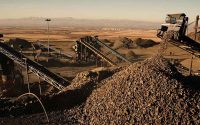There is a never-ending competition for supplying raw steelmaking materials and this is at its fiercest in China as the world’s largest producer and consumer of iron ore. Iran, however, is missing out on the competition and is wholly dependent on Chinese imports.
“Iran is currently the seventh largest iron ore supplier to China-a three-step drop compared to its 2013 heyday,” Keyvan Jafari Tehrani, a member of the board and the head of international affairs at Iranian Iron Ore Producers and Exporters Association, said.
“Naturally, Iran has a meager share of the Chinese [iron ore] market. This is while up until 2013, Iran’s ore exports were both supported by high volumes and global prices in China,” the analyst was quoted as saying by Donya-e-Eqtesad.
According to Tehrani, Iran’s share of Chinese iron ore imports stood at 2.3-2.5% in 2013, but it exported a total of 23.5 million tons, over 90% of which went to China.
The next two years were witness to a large number of Iranian private iron mines’ closure and consequently a sharp drop in exports. The country was overpowered by tough competitors such as Australia, Brazil, South Africa, India, Canada and Ukraine. This brought Iran’s share of Chinese ore imports to only 1%, a figure persisting to date.
Tehrani forecasts Iran’s 2017 iron ore shipments to reach 17-17.5 million tons by the yearend, emphasizing that despite the 6-million-ton drop compared to 2013, the same 90% of it will go to China.
“This is a negative thing; Iran is extremely dependent on the Chinese market, and any change in its dynamics will have an equally powerful effect on Iran iron ore output and exports,” he said.
Why Not Other Markets?
What made Iranian miners addicted to China was the fact that the Chinese were the only buyers paying in cash and circumventing banking sanctions against Iran, says Tehrani.
The official added that the Chinese paid about 30-40% of the amount in cash and the rest through currency exchanges outside the banking system when the cargo was delivered.
And things have not changed now. Sanctions have been lifted “only on paper” and are still in full force, preventing headways in other markets such as Europe, he added.
Issues tangled up further, however. For starters, there were signs of hope of restoring banking relations in early 2016, but Donald Trump’s election as the president of the United States last November cut most advances made on the nuclear deal front.
Also, shipping to Europe means going through the Suez Canal which, according to Tehrani, means higher transportation costs for Iranian vessels due to tariffs.
“The Suez Canal operated in only one line up until August 2015, when the second line was established through Saudi-Egyptian investments. It was all fine at the beginning, but within a few months vessels which departed from or were headed to Iran were mandated to pay higher than standard tariffs to cross the canal,” he said.
The practice was unheard of, according to Tehrani, but was nevertheless implemented and simply raised export costs to Europe for Iranians.
Accordingly, the latest statistics by Islamic Republic of Iran Customs Administration indicate no iron ore exports have taken place to Europe in the seven months of the current fiscal year (March 21-Oct. 22).
Iranian large-scale miners exported 11.09 million tons of iron ore worth $612.6 million during the period, registering an 11.8% and 60.6% growth in tonnage and value respectively, according to the Iranian Mines and Mining Industries Development and Renovation Organization.
Iron Ore Bull Market
Iron ore has recently rallied back into a bull market. Prices are surging, as China’s crackdown on steel output this winter runs down inventories, helping mills’ profitability and stoking demand for high-grade ore even as investors discount signs of ample supply.
Spot ore with 62% of iron content jumped 3.7% to $72.68 a ton, the highest since Sept. 14, according to Metal Bulletin.
That’s more than 20% higher than the low hit in late October, meeting the common bull-market definition, Bloomberg reported.
Iron ore’s gains are buttressed by China’s unprecedented push to rein in steel output this winter to cut pollution. While that initiative may result in less steel being made in the world’s top producer and lower overall ore demand for several months, it has also supercharged prices as inventories collapse.
Citigroup Inc. has singled out iron ore’s bullish prospects in the first quarter of 2018, raising price forecasts for both next year as well as for 2019.
Source: financialtribune





